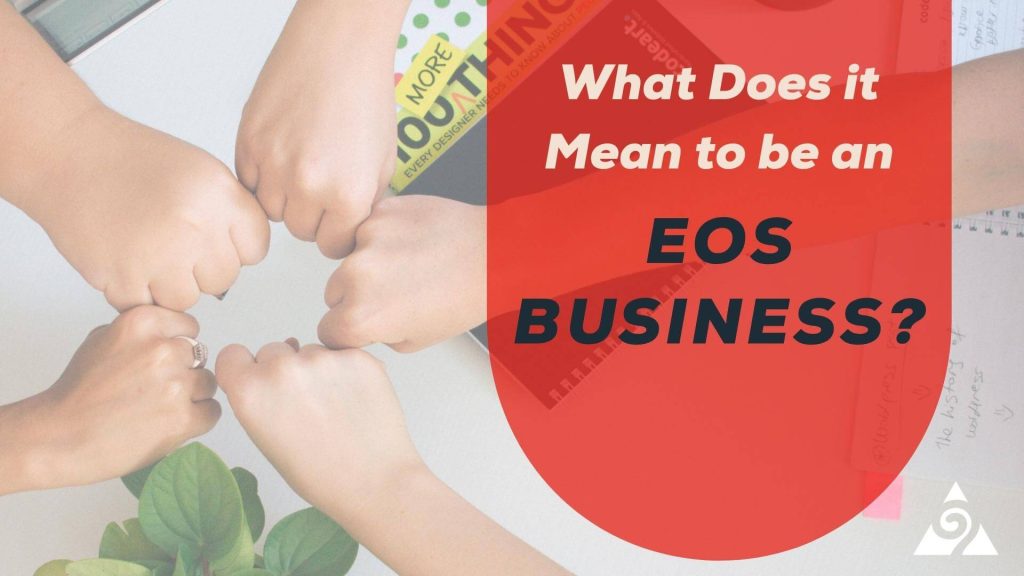Small businesses often lack the focus and organization needed to grow, which is why the EOS business model is so effective. An EOS business, meaning a company that uses the Entrepreneurial Operating System (EOS), follows a set of processes and principles to operate more successfully.
This guide explains the EOS definition businesses use, and it highlights the positive ways that EOS impacts companies. Augurian has been using the EOS plan for over four years, and through it, we have repeatedly reached ambitious revenue and growth goals. But even more importantly, EOS implementation has transformed our company culture and improved how we engage with clients.
What is EOS in Business?
EOS means different things in different industries, so it’s important to clarify that we are talking about the EOS business meaning. The EOS acronym businesses use stands for Entrepreneurial Operating System. The concept goes by many names, including Entrepreneurs OS, EOS process, and EOS model.
At its core, EOS is a people operating system for companies with between 10 and 250 employees. Almost all businesses have operating systems for technology, but they often lack the streamlined cohesion of an efficient system when it comes to managing their employees.
An EOS business focuses on six key components:
- Vision
- People
- Data
- Issues
- Process
- Traction
At Augurian, we apply the core principles of EOS to our work with our digital marketing clients. Our paid media marketing experts can help you implement efficient processes with the right people, data, and traction you need to grow your business.
Where Did the EOS Model Come From?
The EOS model was created by Gino Wickman over 18 years ago and has been used by over 130,000 companies. The EOS traction business model is based on Wickman’s own experience as a successful business owner. Wickman also wrote a book titled “Traction: Get a Grip on Your Business” which serves as a comprehensive EOS summary for business owners. After grasping the EOS meaning, workplaces can use the book to begin executing the model right away.
4 Ways the EOS Business Model Impacts a Business
Now that you can confidently answer the question of what does EOS stand for in business, let’s explore the positive impacts it can have on your company.
Alignment
The first step in the EOS process asks you to clarify your company’s core values and vision for the next ten years. This ensures that each individual at every level of the company has a clear understanding of what you are trying to achieve as a business and the role that they play in that vision.
Every quarter the entire team should review the company’s:
- Core values
- Core purpose
- Marketing strategy
- 10-year target
- 3-year picture
- 1-year goals
- Past quarter goals
- Upcoming quarter goals
Alignment with Clients
We lead our clients through a similar planning process, helping them clarify for us what their most important goals for the year are. Based on these goals, we work with clients to establish quarterly priorities that we agree will help us achieve each annual goal. Augurian’s top-tier content marketing team helps clients articulate their core values and priorities to bring the right people to their companies.
Accountability
Collective accountability is central to the EOS system, meaning there are built-in mechanisms for monitoring tasks and progress. EOS businesses use scorecards that are reviewed weekly to identify if any goals are off-track and what adjustments need to be made.
At the end of each quarter, we do a retrospective and have each team report on what they’ve accomplished. This peer review creates an added level of accountability, and the entire process feels less top-down than traditional goal planning processes.
Accountability with Clients
Scorecards and reports can be used regularly with clients as well. Within these scorecards, you should outline the sub-tasks that need to be completed in order to deliver on each priority. These sub-tasks are assigned to individual team members or individuals on the client-side. This allows us to find success with even the most challenging projects that clients bring to us, including website migration services.
Transparency
Being intentional about following EOS processes takes the mystery out of the work that is being completed. It allows everyone to understand their own responsibilities and what other team members are working on. It ensures that if something is off-track for any reason, it can be surfaced immediately, discussed, and decisions can be made about moving forward.
Common Language
Lastly, EOS provides a common language that everyone can get behind. The adopted terms structure conversations with a high degree of focus on the agreed-upon priorities that the team established. We‘re seeing how a high degree of communication and organization can transform the work that we do both at Augurian and with clients.
EOS Meeting: The L10
EOS meetings, called Level-10 (L10) meetings, also have their own language and structure. So what’s the L10 EOS meeting meaning? An L10 meeting is a specific meeting agenda that helps the group maintain focus throughout the meeting. Using L10 prevents meetings from dragging on endlessly or getting derailed.
The L10 meeting structure has worked so well at all levels of Augurian’s organization that we’ve also adopted this structure for client meetings. It works great to tackle the long-term planning and traction necessary for a successful organic search engine marketing strategy.
Here is what a typical L10 meeting agenda looks like:
- Personal & Professional Good News – 5 min: All meeting attendees are encouraged to engage in personal sharing and relationship-building before digging into the meeting.
- Scorecard & Rock Review – 5 min: Quickly review progress toward completing our goals. If, at this time, anyone surfaces an issue that is impeding anyone’s ability to complete their assigned sub-tasks, we make a note of it and cover it further down in the agenda.
- Headlines & Kudos – 5 min: Headlines are things that are happening or additional context that the group might need because they could impact the team’s work. Kudos are shout-outs to other team members for the great work they are doing.
- To-Do List – 5 min: Every meeting has a running to-do list with individuals assigned to each task and a date for completion. If there is an issue with getting a to-do completed or an update that requires more discussion, we note it and cover it in the next section called the Issues List.
- Issues List – 40 minutes: This is the heart of every meeting. Anything that impedes our progress towards completing our sub-tasks or goals is discussed. Anyone can raise a new issue or new idea that is added to the list and prioritized accordingly. At the end of a conversation about something on the list, there must be a resolution to the issue or a to-do created and assigned for follow-up at the next meeting.
Learn More About Augurian’s Workplace Culture and Values
At Augurian, we combine shared core values and expert digital marketing talent to bring a quality experience to our clients. EOS pairs well with Augurian as we were already a data-focused digital marketing agency with a strong workplace culture. Reach out to us today to learn more about how we leverage the tenets of EOS to provide exceptional service to our clients.
To stay up to date on Augurian’s traction business operating system and other cutting-edge digital marketing trends, subscribe to our blog.





